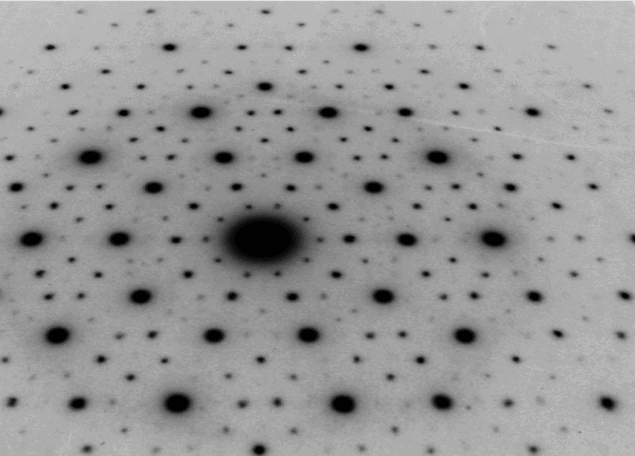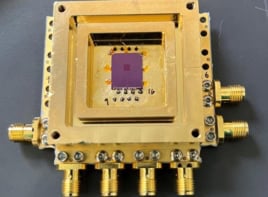
Superconductivity has been observed for the first time in a quasicrystal – a solid material with atoms that are arranged in an ordered pattern that does not have translational symmetry. Keisuke Kamiya and Noriaki Sato at Nagoya University in Japan and colleagues created the quasicrystal by altering the ratio of elements in a specialized metal alloy – and found that it is a superconductor a temperatures lower than 0.05 K. The discovery could lead to the creation of new materials that display fractal superconductivity.
Conventional superconductivity arises when electrons interact with atoms in a crystalline lattice, causing lattice deformations called phonons that propagate through the crystal. These deformations contain pockets of excess positive charge that tend to attract pairs of correlated electrons called “Cooper pairs”. Unlike single electrons, which are fermions, Cooper pairs are bosons and can therefore condense at low temperatures to form a superconductor that flows without encountering resistance.
Long-range order
The atoms in a quasicrystal have long-range order but the pattern of atoms does not repeat itself periodically in space – and therefore a quasicrystal is not a crystalline lattice. As a result, the theory of conventional superconductivity does not describe quasicrystals.
To look for superconductivity in a quasicrystal, the team experimented with an alloy of aluminium, zinc and magnesium that has quasicrystal and crystalline structural phases – depending on the relative abundances of the three metals.
The team began with the alloy in an “approximant crystal” phase that bears some resemblance to a quasicrystal but actually has a lattice that repeats in space. They reduced the aluminium content of the alloy while keeping the magnesium content almost constant and found that the critical temperature marking the onset of superconductivity decreased gradually from about to 0.8 K to about 0.2 K. “However, at 15% aluminium, the alloy transformed into a quasicrystal, and the critical temperature plummeted to about 0.05 K,” says Kamiya.
Dramatic jump
At 0.05 K, the specific heat of the quasicrystal alloy jumped dramatically, and magnetic flux inside the material was almost entirely blocked. These are both important signs that a transition to a superconducting phase had occurred.
The team describe the critical temperature as “extraordinarily low” and say that it explains why it had previously been difficult to observe superconductivity in quasicrystals. Closer inspection of the properties of the quasicrystal superconductor suggest that the formation of Cooper pairs arises from the weak-coupling of electrons. Although relatively uncommon, weak coupling is seen in other materials including the approximant crystal phase of the alloy used in the study.
Dirty superconductivity
According to Sato, this similarity could mean that the observed superconductivity is not related to the quasicrystalline nature of the alloy – but is rather “dirty superconductivity” that occurs in imperfect crystals.
“However, the theory of quasicrystals also predicts another form of superconductivity, based on fractal geometry in quasicrystals. We believe there is a strong possibility that fractal superconductivity makes at least some contribution, and we would be excited to finally measure it.”
The team is examining the interplay between this fractal geometry and the weak coupling electron pairs to explore a new area of superconductivity.
The research is described in Nature Communications.



